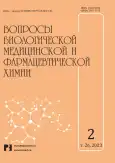Получение и стандартизация оригинальной генотерапевтической конструкции для стимуляции регенерации нервной ткани
- Авторы: Карагяур М.Н.1, Ростовцева А.И.1, Климович П.С.1, Балабаньян В.Ю.1, Стамбольский Д.В.1
-
Учреждения:
- Московский государственный университет имени М.В. Ломоносова
- Выпуск: Том 26, № 2 (2023)
- Страницы: 32-36
- Раздел: Биологическая химия
- URL: https://journals.eco-vector.com/1560-9596/article/view/248400
- DOI: https://doi.org/10.29296/25877313-2023-02-05
- ID: 248400
Цитировать
Полный текст
Аннотация
Травматические повреждения периферических нервов являются одной из самых частых причин стойкой утраты трудоспособности. Проблема регенерации нервных стволов состоит в медленном росте нервных волокон и краткосрочности продукции нейтрофических факторы (NGF, BDNF, NT-3, GDNF и др.), стимулирующих выживание поврежденных нейронов и рост нервных волокон. Естественного регенераторного потенциала в большинстве случаев недостаточно для полноценного восстановления иннервации, что требует проведения заместительной терапии нейротрофическими факторами.
Одним из перспективных терапевтических подходов является применение генотерапевтических конструкций, что позволяет обеспечить продолжительную локальную продукцию факторов, стимулирующих регенерацию в зоне повреждения. Ранее на основе модифицированной плазмидной конструкции pVax1, одобренной FDA (U.S. Food and Drug Administration), авторами была создана бицистронная генотерапевтическая конструкция pNCure (plasmid for Nerve Cure), кодирующая последовательности кДНК мозгового нейротрофического фактора (BDNF) и активатора плазминогена урокиназного типа (uPA), которая продемонстрировала значительную терапевтическую активность на модели травмы периферического нерва у мышей.
Генотерапевтические препараты представляют собой новый класс лекарственных средств, требующих особенного подхода к получению, очистке и стандартизации. В русской литературе практически не встречается информации, посвященной вопросам очистки и стандартизации препаратов данного класса, поэтому подробное их освящение стало темой данной публикации.
В данной работе рассмотрены вопросы получения генотерапевтической конструкции путем ее наработки в клетках E. coli с последующей многоступенчатой очисткой, а также вопросы оценки подлинности генотерапевтической конструкции (методы ПЦР и УФ-спектрометрии), определения родственных и посторонних примесей, определения pH и количества плазмидной ДНК в субстанции. Результаты проведенного исследования демонстрируют, что предложенные способы получения, очистки и стандартизации плазмидной конструкции позволяют получить искомый генотерапевтический препарат высокого качества, удовлетворяющий всем требованиям Государственной фармакопии ХIV, предъявляемым для генотерапевтических препаратов.
Полный текст
Об авторах
М. Н. Карагяур
Московский государственный университет имени М.В. Ломоносова
Автор, ответственный за переписку.
Email: m.karagyaur@mail.ru
к.б.н., ст. науч. сотрудник, Институт регенеративной медицины, Медицинский научно-образовательный центр
Россия, МоскваА. И. Ростовцева
Московский государственный университет имени М.В. Ломоносова
Email: s.rostov94@mail.ru
аспирант, факультет фундаментальной медицины
Россия, МоскваП. С. Климович
Московский государственный университет имени М.В. Ломоносова
Email: lex2050@mail.ru
к.б.н., ст. науч. сотрудник, факультет фундаментальной медицины
Россия, МоскваВ. Ю. Балабаньян
Московский государственный университет имени М.В. Ломоносова
Email: bal.pharm@mail.ru
д.фарм.н., вед. науч. сотрудник, Институт регенеративной медицины, Медицинский научно-образовательный центр
Россия, МоскваД. В. Стамбольский
Московский государственный университет имени М.В. Ломоносова
Email: dstambolsky@gmail.com
к.б.н., вед. науч. сотрудник, Медицинский научно-образовательный центр
Россия, МоскваСписок литературы
- Rasulić L., Savić A., Vitošević F., et al. Iatrogenic peripheral nerve injuries-surgical treatment and outcome: 10 Years' Experience. World Neurosurg. 2017; 103: 841–851.e6. doi: 10.1016/j.wneu.2017.04.099.
- Björkman M.A., Björkman-Burtscher I.M., Mannfolk P., et al. Reconstruction of sciatic nerve after traumatic injury in humans – factors influencing outcome as related to neurobiological knowledge from animal. J Brachial Plex Peripher Nerve Inj. 2012; 7(1): 7. doi: 10.1186/1749-7221-7-7.
- Gordon B. Neurotrophic factors and their receptors in axonal regeneration and functional recovery after peripheral nerve injury. Molecular Neurobiology. 2003; 27(3): 277–323.
- Frostick S.P., Yin Q., Kemp G.J. Schwann cells, neurotrophic factors, and peripheral nerve regeneration. Microsurgery. 1998. 18: 397–405.
- Gu X., Ding F., Yang Y., et al. Construction of tissue engineered nerve grafts and their application in peripheral nerve regenera-tion. Prog Neurobiol. 2011; 93: 204–230.
- Karagyaur M., Dyikanov D., Makarevich P., et al. Non-viral transfer of BDNF and uPA stimulates peripheral nerve regeneration. Biomed Pharmacother. 2015; 74: 63–70.
- Lykissas M.G., Batistatou A.K., Charalabopoulos K.A., et al. The role of neurotrophins in axonal growth, guidance, and regeneration. Curr Neurovasc Res. 2007; 4: 143-151.
- Zhang J.Y., Luo X.G., Xian C.J., et al. Endogenous BDNF is required for myelination and regeneration of injured sciatic nerve in rodents. Eur. J. Neurosci. 2000; 12: 4171–4180.
- Karagyaur M., Rostovtseva A., Semina E. et al. A bicistronic plasmid encoding brain-derived neurotrophic factor and urokinase plasminogen activatorstimulates peripheral nerve regeneration after injury. J Pharm Exp Therapeutics. 2020; 372(3): 248–255. doi: 10.1124/jpet.119.261594.
- Государственная фармакопея Российской Федерации. В 4-х томах. Изд. XIV. М. 2018 (Gosudarstvennaja farmakopeja Rossijskoj Federacii. V 4-h tomah. Izd. XIV. M. 2018).
Дополнительные файлы








